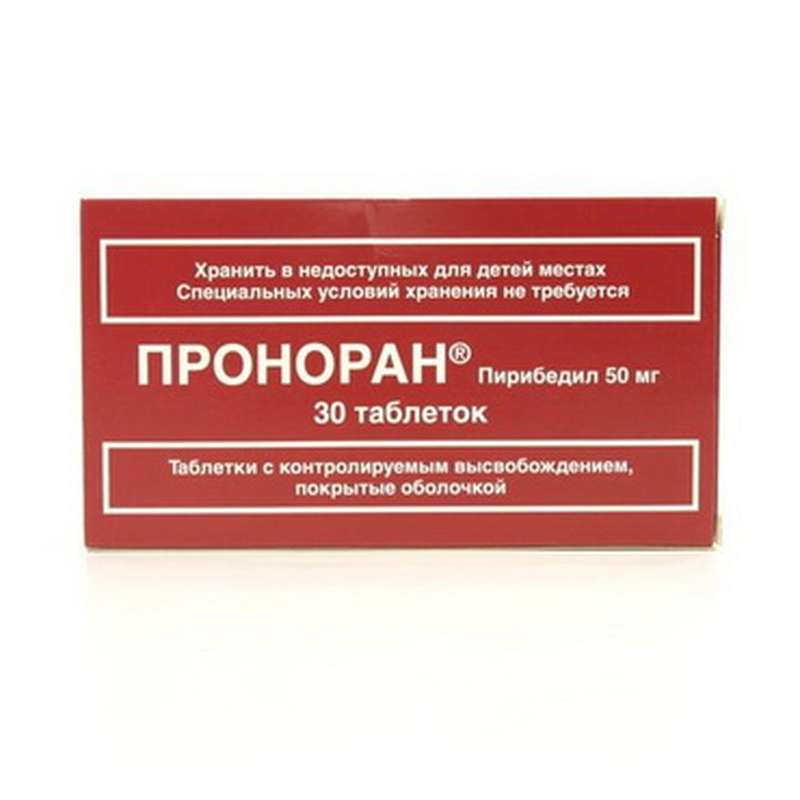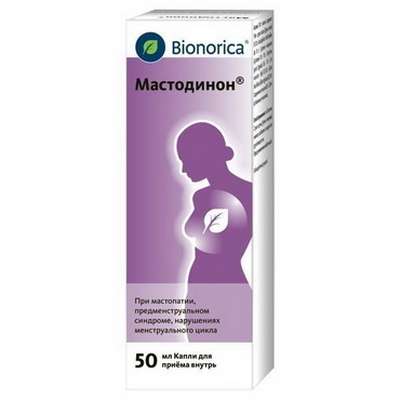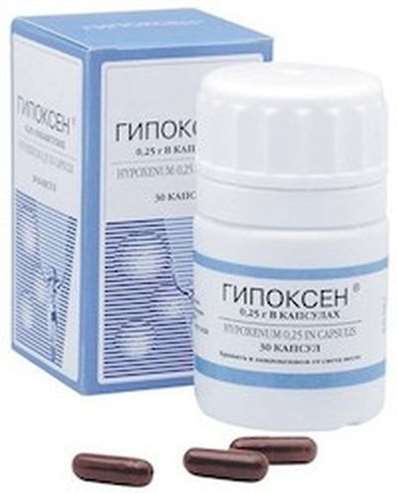Pronoran has an anti-Parkinsonian effect.
Pharmacodynamics
The active substance piribedil is an agonist of dopaminergic receptors. Penetrates into the bloodstream of the brain, where it binds to the dopaminergic receptors of the brain, showing high affinity and selectivity for dopaminergic receptors such as D2 and D3. The mechanism of action of piribedil determines the basic clinical properties of the drug for the treatment of Parkinson's disease both at the initial and later stages of the disease with exposure to all major motor symptoms. In addition to affecting dopaminergic receptors, pyribedil displays antagonist activity of two major α-adrenergic CNS receptors (such as α2A and α2C). The synergistic effect of pyribedil as an α2 receptor antagonist and dopaminergic receptor agonist of the brain has been demonstrated in various models in animals with Parkinson's disease: prolonged use of pyribedil leads to less pronounced dyskinesia than levodopa, with similar efficacy against reversible akinesia, concomitant disease Parkinson's.
In the course of pharmacodynamic studies in humans, excitation of dopaminergic cortical electrogenesis, both during waking and during sleep, was shown in humans, with clinical activity exhibiting various functions controlled by dopamine, this activity was demonstrated using a behavioral or psychometric scale. It has been shown that in healthy volunteers, piribedil improves attention and vigilance associated with cognitive tasks.
The efficacy of Pronoran as a monotherapy or in combination with levodopa in the treatment of Parkinson's disease has been studied in three double-blind, placebo-controlled clinical trials (2 trials compared to placebo and one compared to bromocriptine). The study involved 1103 patients of the 1-3 stage on the scale of Hen and Jahr (Hoehn & Jahr), 543 of whom received Pronoran.
It has been shown that in the dosage 150-300 mg / day, Pronoran is effective in all motor symptoms with a 30% improvement in the Unified Parkinson's Disease Assessment Scale (UPDRS, Part III-motor) for more than 7 months with monotherapy and 12 months in combination with levodopa. The improvement in the II part of the UPDRS scale - activity in daily life - was evaluated in the same values.
In monotherapy, the statistically significant ratio of patients requiring emergency treatment with levodopa receiving pyribedil (16.6%) was less than in the group receiving placebo (40.2%).
The presence of dopaminergic receptors in the vessels of the lower limbs explains the vasodilating effect of pyribedil (increases blood flow in the vessels of the lower extremities).
Pharmacokinetics
Piribedil is quickly and almost completely absorbed from the digestive tract and is intensively distributed.
Cmax of pyribedil in blood plasma is achieved 3-6 hours after oral administration of the controlled-release dosage form. Binding to plasma proteins is average (unrelated fraction is 20-30%). In view of the low connectivity of pyribedil with plasma proteins, the risk of drug interaction when used with other drugs is low.
The plasma elimination of piribedil is two-phase in nature and consists of an initial phase and a second slower phase, leading to a stable concentration of pyribedil in the blood plasma for more than 24 hours.
In a combined pharmacokinetic analysis, it was shown that T1 / 2 of piribedil after IV administration is an average of 12 hours and is independent of the administered dose.
Piribedil is extensively metabolized in the liver and excreted mainly in the urine: 75% of the absorbed pyribedil is excreted by the kidneys in the form of metabolites.
Indications:
- auxiliary symptomatic therapy for chronic violation of cognitive functions and neurosensory deficit in the course of aging (attention, memory, etc.);
- Parkinson's disease: monotherapy (in forms predominantly involving tremor) and as part of combined therapy with levodopa in both the initial and later stages of the disease, especially in forms involving tremor;
- as an auxiliary symptomatic therapy for intermittent claudication resulting from obliterating diseases of the arteries of the lower extremities (2nd stage according to Leriche and Fontaine classification);
- therapy of symptoms of ophthalmic diseases of ischemic genesis (reduction of visual acuity, narrowing of the field of vision, reduction of contrast of colors, etc.).
Contraindications:
- increased individual sensitivity to pyribedil and / or excipients included in the preparation;
- collapse;
- acute myocardial infarction;
- joint reception with neuroleptics (except clozapine);
- Children under 18 years of age (due to lack of data).
With caution: because the composition of the drug includes sucrose, patients with intolerance to fructose, glucose or galactose, as well as patients with a deficiency of sucrose isomaltase (a rare metabolic disorder), the drug is not recommended.
Suggested Use:
Inside, after eating, without chewing, drinking 1/2 cup of water.
For all indications, except for Parkinson's disease - 50 mg (1 tablet) 1 time per day. In more severe cases, 50 mg twice a day.
Parkinson's disease: monotherapy - from 150 to 250 mg (3 to 5 tablets) per day, it is recommended to divide into 3 divided doses; if you need to take the drug at a dose of 250 mg, it is recommended to take 2 tablets of 50 mg in the morning and in the afternoon and 1 tablet in the evening; in combination with drugs levodopa - 150 mg (3 tablets) per day, it is recommended to divide into 3 divided doses.
When choosing a dose in case of its increase, it is recommended to titrate the dose, gradually increasing it by 1 tablet (50 mg) every 2 weeks.
Special instructions:
In some patients (especially in patients with Parkinson's disease) on the background of ingestion of piribedil, a state of severe drowsiness sometimes suddenly occurs until sudden falling asleep. This phenomenon is extremely rare, but nevertheless, patients who drive a car and / or work on equipment requiring a high degree of attention must be warned about this. If such reactions occur, consider lowering the dose of piribedil or discontinuing therapy with this drug.
Given the age of the population receiving pyribedyl therapy, the risk of falls that can be caused by sudden falling asleep, hypotension, or confusion is accounted for.
Patients and their caregivers should be warned about possible symptoms of behavioral disorders (gambling addiction, increased libido and hypersexuality, obsessive desire to shop and compulsive overeating) when taking the drug. If such symptoms occur, consider lowering the dose or gradually stopping therapy with the drug.
Dye crimson, which is part of the drug, in some patients increases the risk of allergic reaction.
Influence on the ability to drive vehicles and mechanisms. Patients with episodes of severe drowsiness and / or sudden falling asleep during piribedil therapy should refrain from managing vehicles and equipment requiring a high degree of attention until these reactions disappear.
Side effects:
From the gastrointestinal tract: minor gastrointestinal symptoms (nausea, vomiting, flatulence), these adverse reactions are reversible in the selection of the appropriate individual dose. Selection of a dose by gradually increasing the dosage (50 mg every 2 weeks until the recommended dose) leads to a significant decrease in the manifestation of these side effects.
From the side of the central nervous system: there may be mental disorders, such as confusion, hallucinations, agitation or dizziness that disappear when the drug is withdrawn.
Taking pyribedil is accompanied by drowsiness and in extremely rare cases can be accompanied by pronounced drowsiness during the daytime until sudden falling asleep.
From the CCC side: hypotension, orthostatic hypotension with loss of consciousness or malaise, or lability of blood pressure.
Allergic reactions: the risk of developing allergic reactions to the scarlet dye, which is part of the drug.
Packaging:
- Comes in original packaging. Item is brand new and unopened.
Storage:
- Keep away from direct sunlight.
- Keep locked and away from children.
- Store in dry place at room temperature.
- Do not exceed storage temperature higher than 25 C
Important notice- the outer box design may vary before prior notice!

 Cart
Cart





